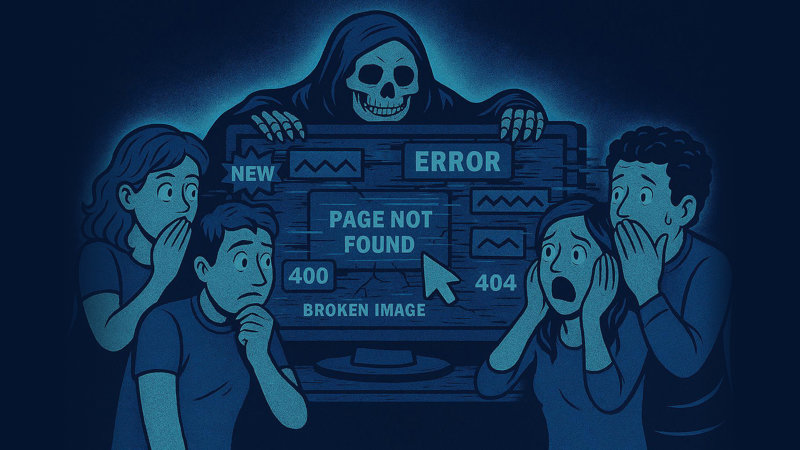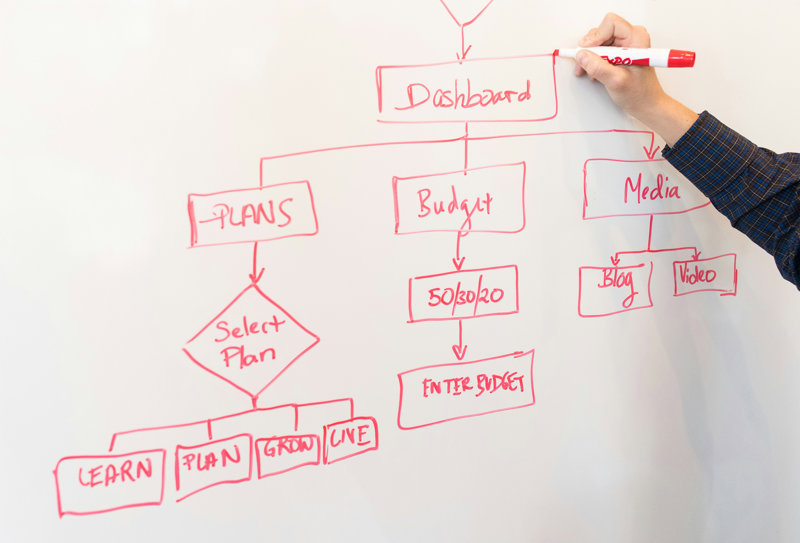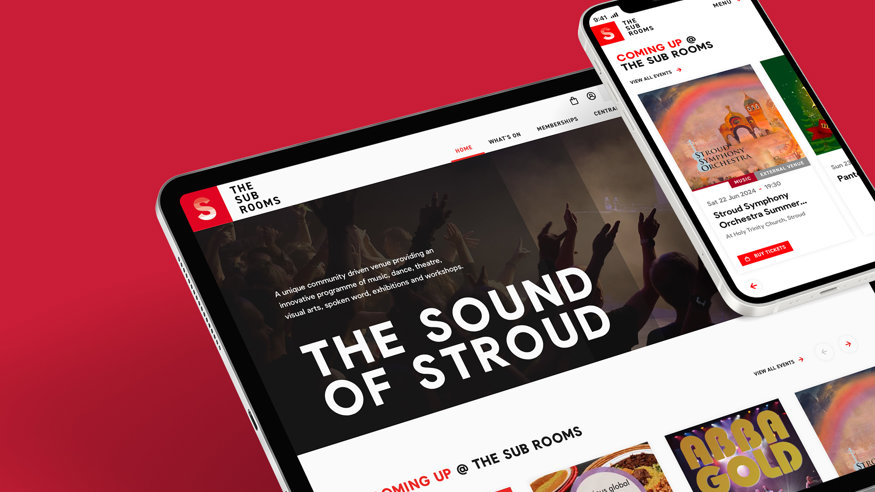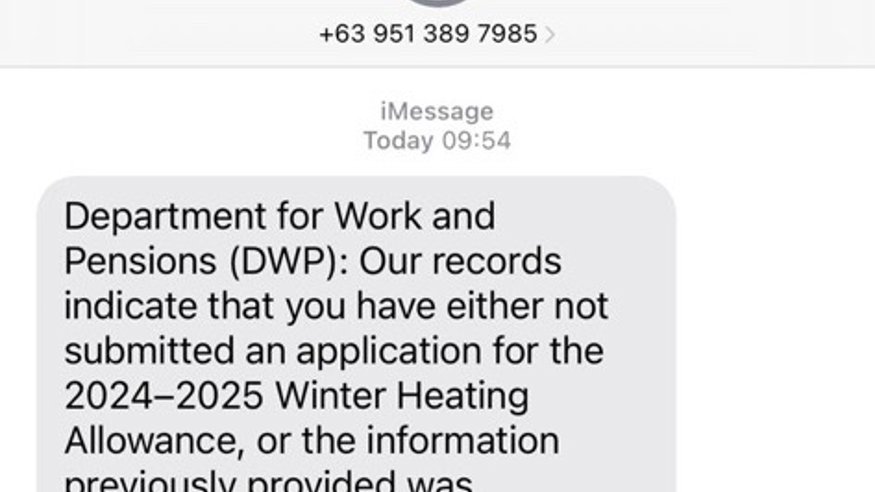How to avoid website project horror stories!

Maybe you've been there before, maybe this is your first time creating a website. We have seen website projects at all stages turn from dreams into nightmares very easily, often being the ones at the other end helping our soon to be clients put it back on the right path.
We know and understand all too well that creating a website is a major investment of time, money, and creative energy for you. Whether you're building from scratch or redesigning an existing site, poor planning and management can lead to missed deadlines, bloated budgets, and a final product that doesn’t meet yours or your audiences expectations or even completely derails and never sees the light of day because it's just too much of a challenge to get live.
If you are in the early stages of thinking about starting a new website project or refreshing an existing one, or perhaps you current project is going through a nightmare stage we are here to help, either as your digital partner or just provide some useful advice that will hopefully get your project back on track.
We have compiled a breakdown of the items or issues that we hear come up time and time again and have worked with our clients on to avoid many if not all of these pitfalls. Through our processes we have learnt the best ways that we now advise our clients to follow to set their project up for success. Hopefully we can help you with many of these issues and others but this advice applies whether you are choosing us as your digital partner or another agency.
Here’s our 10 tips to help you avoid a nightmare website project:
1. Draft a brief / specification for the project.
2. Create a sitemap for your website.
3. Set yourself a realistic budget.
4. Do your research on digital agencies
6. Ensure you have access to your domain name.
7. Provide access to third-party platforms you use.
8. Write or prepare your content.
1. Draft a brief and/or specification for the project.
Before you do anything we highly recommend you take some time, sit down and draft a detailed brief. It will form your project's foundation, communicating your vision, goals, and requirements to the agency taking on the project. Not only that it will help you to get ideas straight in your mind and align all the members of your team that will be working on the project.
Include background on your business, target audience, and brand personality. Outline the features you need—such as e-commerce, booking systems, or multilingual support—and any integrations with third-party platforms. Share design preferences, tone of voice, and examples of websites you admire. The more specific you are, the easier it is for the agency to deliver a solution that meets your expectations.
Actions to Take:
1. Write a 1–2 page overview of your business and goals and what you hope to achieve with the website / web refresh.
2. List required features and technical specifications. Include design inspiration and brand guidelines.
3. Define your audience and desired user experience.
4. Clarify what success looks like (e.g., sales, conversions, engagement).
2. Create a sitemap for your website.
It may feel like it's too early in a projects lifecycle to be doing a sitemap but it can be a huge asset for you, your team as well as any agency you are asking to quote on the project. If you don't know what a sitemap is it is effectively a visual representation of your website’s structure. It helps you organize and map out content and plan user journeys. It can also help identify pain points in existing sites that you hope to design out of any refreshed version.
Even a rough sketch showing a high level view of the main pages and subpages can guide the design and development process. It will help everyone involved think about how users will navigate your site and what actions you want them to take. A clear sitemap also helps identify content gaps and ensures nothing important is overlooked.
Actions to Take:
1. List all key pages and group them into logical sections.
2. Consider user flow from landing to conversion. What steps do you want a user or potential customer to take. What's the shortest route to your success metric.
3. Grab trusty old pencil and paper or use online tools like FigJam, Miro or Lucidchart to create a visual map.
4. Share your sitemap with your team and prospective agencies for feedback.
5. Update it as your content and strategy evolve. It is likely that the agency you choose will want to help you refine this as part of the planning process.

3. Set yourself a realistic budget
Budgeting isn’t just about what you can afford or trying to get the price as low as possible, it should be about aligning expectations. A realistic budget helps agencies propose solutions that match your needs from the brief and specification document without cutting corners. Prospective agencies can than review this and consider all aspects of the project that may benefit you and your business, tailoring their proposal for what you need and could realistically afford. This would typically include design and development, content creation, SEO, hosting, and ongoing maintenance. Don’t forget to factor in any costs for third-party tools or other assets such as stock imagery or video that may impact the final spend. If your budget is tight, prioritize core functionality and plan for phased enhancements later.
The most important factor to keep in mind is that transparency is key. Share your budget early so agencies can tailor their approach accordingly. If nobody has an idea about budget going into the proposal stage the gap between your expectations and what the agency quotes is going to be vast and you may end up ruling out the right agency because they didn't provide you with the price you were expecting.
Actions to Take:
1. Define your total budget and have at the very least a rough idea of where you want to allocate that budget.
Do you need minimal design but lots of complex integrations? Do you want this to be a design-heavy project.
2. Include a 10-20% contingency for unexpected costs.
Any project has the tendency to end up with increased costs, not matter how much structure and management you or the agency put in place. Our advice is always be prepared for this and work with your agency to minimise.
4. Consider setting aside a small portion of your fee for exploration.
The value you will get from an agency is not the tangible end product, it's the thinking that drives success with that website in this instance and this takes time so some agencies may want to take a small fee to research and ideate as part of the initial consultation. They should provide you with a report which you can take away if you decide not to use them. A proposal will likely provide a ballpark figure or range. Once you have chosen you agency and had further discussions ask for a more itemized quote and payment schedules so you can manage these better informed.
5. Consider long-term costs like hosting, updates, and support.
Is it worth considering a support package or retainer so you can spread support costs.
6. Be honest about your financial limits to avoid scope creep.
This can happen from both sides. Clear understanding of limits will allow your digital agency to manage this with you.
4. Do Your Research on digital agencies
Choosing the right digital agency is arguably the most important decision in this process. A good agency will act as a strategic partner, not just a service provider. They should be someone you can work with for a long time and can trust to be there when you really need them. Start by reviewing their portfolio, you want look for diversity in design, functionality, and industries served, equally you may want someone who has worked in your industry before and therefore has experience and knowledge to help deliver what you need. Read client testimonials and case studies to understand how they work and what results they’ve delivered. Don’t hesitate to ask for references or speak directly with past clients. Make sure their communication style suits yours, and that they’re transparent about timelines, costs, and expectations from both sides A discovery call should leave you feeling confident, not confused.
Actions to Take:
1. Review 3–5 agency portfolios and shortlist your top picks.
Ensure you look beyond just the surface level. A beautifully designed site doesn't always meet business objectives or provide you with the tools for success. Look for how the agency has solved a business problem or objective.
2. Consider setting aside a small portion of your budget for exploration.
The value you will get from an agency is not the tangible end product, it's the thinking that drives it, the website in this instance. This can't always be gleaned from a surface level review of your site or brief, this takes time. Therefore some agencies may want to take a small fee to research and ideate as part of the initial consultation. They should provide you with a report which you can take away if you decide not to use them.
3. Ask about their processes
Get to know them and ask questions and how they work, team structure, and revision policy as well as ownership of all the final assets created for this project.
4. Ensure they understand your brand, audience, and goals.
Make sure you provide them with everything they need to know early on so they have a chance to get to grips with your brand, goals and aspirations and this will enable you to assess their capabilities as well as understanding.
5. Check if they offer post-launch support or training.
A website is not a done and leave asset, it needs maintenance, it will evolve and likely things will go wrong over time. You need to know you have a partner that will be there for you and not ghost you when you need them the most.
5. Set Yourself a Deadline
Deadlines give your project structure and momentum. Whether you're launching for a campaign, event, or seasonal push, or even if there is no specific reason or need for a deadline having one creates a clear timeline that helps everyone stay focused. Work backwards from your ideal launch date and build in time for discovery, design, development, testing, and revisions. Be realistic—rushing leads to mistakes and missed opportunities. Share your ideal timeline with the agency early so they can review, feedback any challenges or potential obstacles to achieving this and allocate resources and plan accordingly.
Actions to Take:
1. Choose a launch date and identify key milestones.
These need to be realistic and achievable by everyone involved, this includes you and your team because a blockage can occur on either side, agency or client.
2. Build in buffer time for feedback and testing.
Things go wrong or the unexpected always rears its ugly head at the most inconvenient of times. Always ensure you have left enough time to deal with these and it not feel like you are a week out from launch and have a ton of work still to do.
3. Use project management tools to track progress.
Your agency may have a tool of choice or there are a number of systems out there to choose from. Always work with your agency on this to ensure you are aligned with how the tool is used, by whom and clear processes to get the best outcome.
4. Communicate deadlines clearly with all stakeholders.
This is one of the biggest obstacles for successful delivery of a project, communication! Even the slightest missed update or lack of clarity can create massive headaches. Ensure you have regular, clear and transparent communications and people don't feel the need to hide when a problem needs to be raised. Include the appropriate people at the appropriate time and setup a way that everyone in the team can get a glance without needing to play email tennis to get an update.
5. Be flexible if quality requires more time.
Our view with clients has always been to be right or better than fast and to a deadline. It's not worth rushing something out and it not being right just to check a deadline box. Hopefully if you have managed to implement the above this should not be an issue, but always be prepared to be a bit flexible to achieve the best outcome.
6. Ensure you have access to your domain name
Your domain name is your digital identity. If you already own one, make sure you have full access to the registrar account and DNS settings. If you’re purchasing a new domain, do it early to avoid delays. Domain access is essential for launching your site, setting up email, and configuring security certificates. Losing access can cause serious setbacks, so keep credentials secure and backed up.
Actions to Take:
1. Locate your domain registrar and confirm login credentials.
2. Check renewal dates and update contact information.
3. Share access securely with your agency if needed.
4. Consider purchasing related domains or redirects.
5. Set up domain-based email addresses if required.
7. Provide access to third-party platforms you use
Most websites rely on third-party platforms for functionality—whether it’s a CRM, email marketing tool, booking system, or payment gateway. Your agency will need access to these platforms to integrate them properly. Prepare login credentials or invite them as collaborators. Document how these platforms support your business so the agency can design around them effectively.
Actions to Take:
1. List all platforms and tools your website will connect to.
2. Confirm they offer APIs or plugins for integration.
3. Prepare access credentials or create agency accounts.
4. Document workflows and data flows for each platform.
5. Test integrations before launch to ensure functionality.
8. Write or Prepare Content
Content is often the biggest bottleneck in web projects. Start writing early - don’t wait until the design is finished. Your content should be clear, engaging, and aligned with your brand voice. Include headlines, product descriptions, team bios, and calls to action. If you’re hiring a copywriter, brief them thoroughly and align timelines with the design phase. Well-prepared content speeds up development and improves user experience.
Actions to Take:
1. Create a content inventory for each page.
2. Write copy that’s concise, benefit-driven, and SEO-friendly.
3. Use consistent tone and formatting across pages.
4. Hire a professional copywriter if needed.
5. Finalize content before development begins.

9. Gather and Optimise Content
Visual content plays a huge role in how users perceive your brand. Gather all necessary assets - logos, product photos, team headshots, icons, and videos. Ensure they’re high-quality and consistent in style. Optimise images for web to reduce load times and improve performance. Poorly prepared media can slow down your site and hurt user experience, so take time to get it right.
Actions to Take:
1. Collect all visual assets and organize them by page.
2. Use tools like TinyPNG or ImageOptim to compress files.
3. Ensure images are high-resolution but web-friendly.
4. Maintain consistent branding and style.
5. Name files clearly for SEO and developer reference.
10. Building it is only the Beginning...
People rightly or wrongly assume that once they have a great site that functions how they want that the hard part is done. This simply is not the case.
Do you remember the film Field of Dreams and the famous line:

This is simply not the case and actually the film is the perfect analogy for your website project. If you have a house / baseball field out in the middle of nowhere and you have built no roads, put up no directional signs or even told anyone about it how do you expect them to turn up? The same applies to web design.
Don't just sit back and wait, you won't be found. You need to create clear signage through your sites technical setup and utilising third tools to tell search engines and AI algorithms that your site exists; create content and landing pages they can crawl, rank and present your site to people looking for what you offer; and utilise advertising and social media posting alongside more traditional adverting and word of mouth to generate the exposure and traffic for your site to help it be seen by your potential clients or customers.
Actions to Take:
1. Ensure the site is correctly setup for SEO
Working with us or you digital agency of choice to ensure you have all the tools to setup the correct technical structure for the site including the right heading hierarchy (H1, H2, H3 etc), metadata is in place, sitemaps are easily found or submitted to the search engines etc. Ensure you add an analytics tool so you can monitor your site and work with your agency to add it to the site.
2. Review and optimise your content
From inclusions of keywords and phrases in your copy to captions and naming image files with searchable terms, whilst small steps these little items can make a significant difference to how your site performs in search. Don't just look at having written some content as the end. It may be what you want to say, but it may not be what people are looking for and you only learn this through experimenting and reviewing your metrics and analytics. Tailor it for your audience to maximise impact whilst still getting your unique point of view across.
3. Generate authority with desired content and link building
Creating content that people may be looking for (like this very article) helps generate traffic, that traffic as it grows that creates authority signals for search engines which generates further exposure. Add into this having your content featured and linked back to by other third party sites also helps. All this layering builds the "roads" that lead people to your site and make it easier for people to find you.
4. Consider using Social Media or Paid Adverstising.
Don't just rely on your audience finding you, take the message to the places they hang out, whether it's Facebook, Linkedin or other sites. Determine the best way to reach the people you need to generate awareness and traffic. As this grows the hope is your organic traffic will grow and you can reduce or better target any paid forms of advertising.
Final Thoughts...
Website design doesn’t have to be a nightmare. With thoughtful planning, clear communication, and organized assets, you can turn a complex project into a smooth, rewarding experience. Treat your website like any other strategic initiative - invest time upfront, collaborate with the right partners, and stay focused on your goals.
If you are looking for an agency or digital partner that can help you with some of these nightmares and more then get in touch with our team.
Share article:

Upgrading to Umbraco 17: a strategic investment for your business
Used and trusted by both developers and marketers, Umbraco offers a high level of customisability, with the latest long-term-supported (LTS) version (Umbraco 17) currently scheduled for release in November 2025. Featuring improved performance and developer tooling, alongside support for the latest .NET versions, Umbraco 17 offers a number of benefits including enhanced security, streamlined workflows, and improved scalability.
Read more
Exploring the benefits of Umbraco 17: a leap forward in CMS flexibility and performance
Umbraco has long held the reputation as a flexible, developer‑friendly content management system (CMS) and with the release of Umbraco 17 scheduled for November 2025, the platform is continuing to evolve. Umbraco 17 will be the next Long‑Term Support (LTS) version, aligned with the upcoming .NET 10 LTS release, and is expected to include enhancements in performance, developer experience, and content workflow modernisation.
Read more
The future is bright for the Sub Rooms
New website and Spektrix integration helped Sub Rooms turn a corner
Read more
Website builders vs bespoke: which is right for your business?
In a digital-first world, a company’s website (and its overall effectiveness) is of paramount importance, serving as both the first impression and initial introduction to a brand. Traditionally built from the ground up by experienced developers, website creation has become increasingly accessible, primarily due to the rise of website builders such as Squarespace, Wix, Weebly, and Webflow, These platforms offer powerful tools, sleek templates, and rapid setup options, without the need for direct developer involvement. However, for businesses with more complex or unique requirements, they can be limiting, with many instead opting for bespoke development tailored to the specific project goals, workflows, and user experience. This blog outlines the pros and cons of each –off-the-shelf website builders vs bespoke development.
Read more
How to spot a text message, iMessage or WhatsApp scam
Top 6 red flags for suspicious text messages
Read more
Benefits of team building away days
We were delighted to welcome South West HR consultants, Rise HR, for a for a training day
Read more
16i x Spektrix | Partnership announced
We’re incredibly proud to become a certified Spektrix partner. Having worked with a variety of arts organisations over the years, we know how vital it is to connect digital platforms with the ticketing and CRM systems they rely on.
Read more
Spektrix: a detailed guide
Utilised by a global user-base, Spektrix has become the market leader in back office and digital marketing systems, primarily within the arts industry. This blog explores what it is, who uses it and most importantly, how it could benefit your business.
Read more